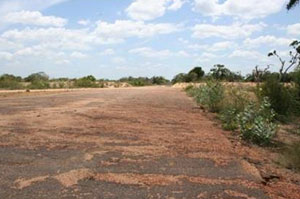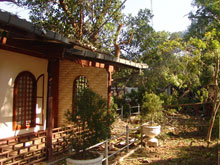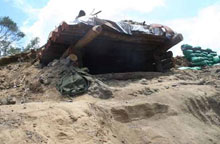The Army's 57 Division is still poised to re-capture Kilinochchi, until recent weeks the centre of political power of the Liberation Tigers of Tamil Eelam (LTTE).
Last Thursday, they fought some fierce battles with Tiger guerrillas at Akkarayan, ahead of the township of Kokavil on the A-9 highway. It lay in their advance in an easterly direction. From here, the stretch northwards to Kilinochchi lay abandoned after civilians had moved out. However, the guerrillas have fortified their defences. Troops have also broken through what has now come to be known as a "ditch cum bund" and advanced northwards. As a picture on this page shows, bunkers have been built atop the bund constructed by guerrillas using earthmoving equipment. An eight to ten feet ditch lay ahead of them. The guerrillas expect the ditch to be flooded with the full onset of the northeast monsoon.
 |
| The abandoned airstrip at Pannikankulam which the Air Force says was used for training purposes. |
One such fortification is across the Therumurukandi-Akkarayan road, the scene of pitched battles on Thursday. Troops have offered fierce resistance to attempts by guerrillas to counter attack. Both sides suffered casualties. Troops are keeping the pressure on their enemy and directing artillery fire to targets in Kilinochchi. Multi-barrel rockets were also raining in on guerrilla positions ahead of Kokavil.
The intense ground battles saw the Air Force stepping up its their campaign. As fighting continued on Friday, several targets in Kilinochchi were bombed. This included the so-called Tamil Eelam Police Headquarters, the head office of the LTTE Political Wing and the adjoining Peace Secretariat. The head office was the location where guerrilla leader Velupillai Prabhakaran met visiting foreign dignitaries.
Aerial footage of Kilinochchi town and its environs in the aftermath of the air raids, seen by senior security officials in Colombo, showed debris from buildings strewn all over. If a township had taken shape in Kilinochchi after the Norwegian-brokered Ceasefire Agreement of 2002, the area now looked a ghost town with crumbled buildings and burnt-out vegetation. Most buildings were without roofs with collapsed walls. The extensive damage caused to the political offices of the LTTE caused ripples in sections of Colombo's diplomatic community.
Tiger guerrillas were urging even the small number of civilians who had chosen to remain to leave Kilinochchi immediately. This was after many areas near the town came under artillery barrages. Multi-barrel rockets were also falling at locations south of the town area.
 |
 |
| Tamilnet photos of the two buildings that formed the Political Headquarters of the LTTE in Kilinochchi bombed by the Air Force on Friday. |
Only a few remnants of the LTTE infrastructure are said to remain in Kilinochchi. They include the base hospital. However, reports from Kilinochchi said part of the equipment as well as patients were shifted to a 350-bed new hospital the LTTE had constructed in Puthukudiyiruppu. Skeleton staff, with a few files, have moved their operations from the Kachcheri to Dharmapuram. Most LTTE camps have been moved to Puthukudiyiruppu with a few to Viswamadu, both in the Mullativu district.
The guerrillas have also shifted location from some parts of the A-9 highway falling back to the old Kandy road. It runs parallel to the A-9 highway. On the other hand, small groups of soldiers or “forward elements” operating behind enemy lines have taken up position at some undisclosed locations along A-9.
Troops of the Army's 57 Division this week stumbled on a site, which they believe was an abandoned airstrip. This was when they were clearing scrub jungle at Pannikankulam, located northwest of Mankulam. The 500-metre long and 50 metre wide tarred area is located in a stretch, which was once part of the Jaffna-Colombo railway. However, senior Air Force officials say this abandoned airstrip was a “dummy” used only for training purposes. They say that all operational activities of the "LTTE Air Wing" had been concentrated in areas east of the A-9 highway.
Another flank on which troops of the Army's Task Force 1 are fighting fierce battles is the general area east of Nachchikuda, once home for a major Sea Tiger base. Here, troops are still to regain control of the coastal village of Nachchikuda. Guerrillas have offered strong resistance in this sector where a successful advance would lead troops to Pooneryn. As previously reported, this would pave the way for a land-based route from Mannar to Jaffna. This is with the expected revival of the Sangupiddy ferry across the Kilali lagoon.
Troops of the 59 Division who are advancing from the Weli Oya sector have made an interesting find. They earlier stumbled on the LTTE's 14 base, a known hideout for guerrilla leaders which was in full use when Indian Peace Keeping Troops (IPKF) were in Sri Lanka. Though it has since been abandoned, guerrilla intelligence cadres who were conducting surveillance on troop positions had used some of the buildings periodically.
Now, the troops have stumbled on another hideout, which showed that the guerrillas had built a string of underground shelters. In the many months after the Ceasefire Agreement of 2002, it was well known that enormous quantities of cement and steel were transported to the Wanni. Then, authorities who kept track of this development were unable to discern the reasons since construction activity, like the erection of buildings or houses, did not match the vast quantities of cement.
 |
 |
| Entrance to the LTTE underground shelter on the east coast near the Nayaru lagoon. |
Flight of steps leading to the underground shelter. |
The pictures on this page show one such underground shelter located near the eastern coast closer to the Nayaru lagoon. The entrance to this shelter gives the appearance of a small hut. However, it is the entrance to the underground shelter through a flight of steps. Foliage from large trees makes it less visible from air.
Intelligence circles in Colombo are puzzled over why the guerrilla leadership in the Wanni had ordered its cadres from the Jaffna peninsula to return there. As reported last week, they had also directed cadres from Trincomalee, Batticaloa and Ampara districts to leave Wanni and return to their respective units.
Although it is known that the main aim would be to compel the Army to thin out, the question remains why the guerrillas who are under tremendous pressure have chosen to resort to that action. Logically their priority would have been to defend their key strongholds now under threat.
 |
| A Tiger guerrilla bunker built on a bund constructed by them at Akkarayan |
Armed forces commanders, The Sunday Times learnt briefed President Mahinda Rajapaksa on Wednesday about the ground situation in the battle areas. This was after he returned to Sri Lanka from New York where he addressed the United Nations General Assembly. The meeting of the National Security Council also saw a new entrant, Treasury Secretary Sumith Abeysinghe. Sources at the office of the Commissioner General of Essential Services said Commissioner S. B. Divaratne also briefed the Council on the food situation in the Wanni. According to him, at least three months stocks of food were available.
There were a number of other developments this week. Defence Secretary Gotabhaya Rajapaksa left for Moscow yesterday on a weeklong visit leading a top level Army delegation. It comprised Brigadier Udaya Perera, Director (Operations) and Brigadier Mahesh Senanayake, Director Plans at Army Headquarters.
At Air Force Headquarters, Air Vice Marshal Harsha Abeywickrema has been appointed as the Deputy Chief of Staff. He was earlier Director, Air Operations. He is succeeded by Air Vice Marshal Kolitha Gunawardena.
The New York based Human Rights Watch announced on Friday that US President George W. Bush has signed into law the Child Soldiers Accountability Act, details of which were published in the Situation Report last week. A statement said "leaders of military forces and armed groups in Sri Lanka who have recruited child soldiers may be arrested and prosecuted in the United States." The new Act was introduced by Senator Richard Durbin of Illinois and adopted unanimously by both the US House of Representatives and the Senate last month.
The HRW statement quoted its children's right advocate Jo Becker as remarking, "the US is saying to the world that using child soldiers is a serious crime and that it will take action." He adds " Military commanders who use children can no longer come to the United States without the risk of ending up in jail." HRW has accused both the LTTE and the Tamil Makkal Viduthalai Pulikal (TMVP) of recruiting children.
Until Friday, troops have kept the pressure on the guerrillas.
There was a relative lull in the Wanni battlefields yesterday. Some senior ground commanders joined their colleagues including senior officers at a religious ceremony at the Sri Maha Bodhi in Anurahdapura. Flags of all regiments in the Army were blessed by leading members of the Buddhist clergy in Anuradhapura. Troops are yet to re-capture Kilinochchi or for that matter regain control of Kokavil. As their thrust continues, the days and weeks ahead will be decisive. It will be a pointer to which way the two and half decade old separatist war is headed. |






